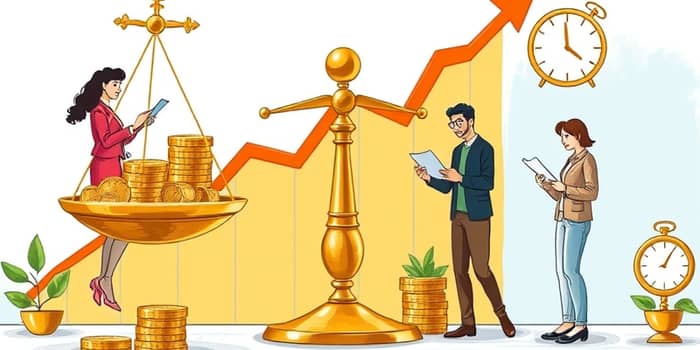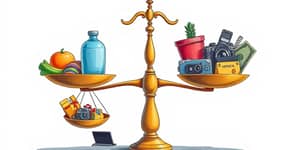
Interest rates are at the heart of every financial decision we make, from buying a home to stashing money in a savings account. Understanding how rates fluctuate, why they matter, and how they affect your wallet can empower you to take charge of your financial future. This comprehensive guide breaks down the essentials of interest rates, examines the current global environment, and offers practical advice for borrowers and savers alike.
At its core, an interest rate represents the cost of borrowing money or the reward for saving. Expressed as a percentage of the principal, it determines how much extra you pay when you borrow or gain when you save. There are two primary measures:
Nominal interest rates refer to the stated percentage without adjusting for inflation, while real interest rates subtract inflation to reveal the true purchasing power of returns or costs. As inflation erodes the value of money over time, understanding both nominal and real rates is key to making informed choices.
Interest rates are the lever through which central banks and markets regulate economic activity. For borrowers, rates dictate the affordability of mortgages, credit cards, student loans, car financing, and business credit. For savers, rates determine returns on savings accounts, certificates of deposit, and bonds. At a macro level, rates steer consumer spending, shape business investment plans, influence housing markets, and ultimately guide economic growth.
When rates are low, borrowing becomes cheaper and spending tends to rise, potentially fueling growth. Conversely, high rates can cool inflation by discouraging debt and curbing demand. Recognizing this delicate balance helps individuals anticipate market shifts and adjust their strategies accordingly.
Following aggressive hikes in 2022 and 2023, central banks began coordinated cuts in mid-2024 as inflation eased in many developed economies. Below is a snapshot of key regions as of July 2025:
Global forecasts suggest continued rate cuts into 2026 as inflation trends toward central bank targets. However, geopolitical risks and supply chain disruptions could prompt renewed tightening in some regions.
Managing inflation is a central bank’s primary mandate. When inflation rises above target levels, central banks hike rates to cool spending and bring prices under control. Conversely, when growth slows and inflation dips below target, they cut rates to stimulate borrowing and investment.
For example, the European Central Bank raised its deposit rate from 0% in January 2022 to 4.5% by September 2023, then began cuts as inflation normalized. The Federal Reserve, having peaked at nearly 5.25%, now forecasts two further cuts by year-end 2025. These shifts illustrate how core inflation pressures drive monetary policy decisions worldwide.
Changes in interest rates directly affect loan affordability. Higher rates mean larger monthly payments and increased total interest costs. Lower rates reduce payments but can tempt borrowers to overextend, risking financial strain if rates rebound.
Understanding the fine print—such as caps on ARM resets or prepayment penalties—ensures borrowers can align their choices with risk tolerance and financial goals.
Savers reap the benefits of higher rates through increased yields on bank deposits, CDs, and investment-grade bonds. When rates decline, however, real returns can be eroded by inflation, leading to negative real interest rates if price growth outpaces earnings.
To maximize returns, savers should compare yield curves, consider laddering CDs to lock in rates at staggered maturities, and explore government-backed securities for both safety and attractive yields in a high-rate environment.
Beyond central bank policy, personal financial factors determine the specific rates you receive on loans or investments. Key drivers include:
Finding the best loan requires careful research and comparison shopping. Start by gathering essential documentation—credit history, pay stubs, bank statements, and proof of income. Then, evaluate offers based on these criteria:
Use online calculators to model total costs under different scenarios and negotiate with multiple lenders to secure the most competitive package.
Consider a $100,000 home with a 2% property tax rate: annual taxes of $2,000 translate to just $167 per month in local levies. A 30-year fixed mortgage at 4.5% carries a principal and interest payment of approximately $507 monthly. By contrast, a 5/1 ARM might start at 3.75%, reducing initial payments to $463, but with potential resets tied to market rates.
On the savings side, a 1% yield on a high-yield savings account generates $1,000 annually on a $100,000 balance—versus $4,500 if parked in a 4.5% certificate of deposit.
Small changes in rates can have profound effects over decades. A 1% increase in mortgage rate can add tens of thousands in interest across a 30-year loan. Similarly, locking in higher yields when saving can compound into significant wealth accumulation. By cultivating informed financial choices, individuals can avoid costly mistakes and harness the power of compounding to reach their goals.
Many fall into the trap of focusing solely on the monthly payment, neglecting total cost. Others underestimate risks associated with adjustable rates or ignore ancillary expenses such as insurance, taxes, and maintenance. To navigate these pitfalls:
• Always calculate the lifetime cost of borrowing, including fees and expected rate changes.
• Beware of teaser rates that can spike after initial periods.
• Factor in ancillary homeownership costs—insurance, taxes, and maintenance—when budgeting.
• Seek professional advice or counseling programs if you’re a first-time buyer.
Armed with this knowledge, both borrowers and savers can confidently navigate the ever-changing landscape of interest rates. By understanding what drives rates, how they interact with inflation, and which personal factors influence your individual rate, you can make strategic decisions that align with your financial goals and secure a more stable, prosperous future.
References













